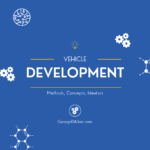Use of Statistics: New Applied Philosophy Craft Advanced Tech

Use of Statistics - Craft Advanced Tech:
The purpose of this article is to delve into the Systems Engineering philosophical approach in utilization of the “statistics” as a tool, and its applicability to the development of the complex advanced technologies.
Introduction: Statistics in Industry Today - General Observations
Traditionally, Statistics or statistical methods have been employed for quality control, reliability testing, and performance optimization in the automotive industry. Consequently, in recent years, however, advancements in machine learning and big data analytics have revolutionized product development, enabling more precise and adaptive technologies. Furthermore, modern vehicle systems leverage statistical algorithms to process vast amounts of data from various sensors for high-level functions. Moreover, this capability is crucial for deploying advanced safety features like adaptive airbags and seatbelt pre-tensioners, which adjust based on the size, position, and posture of the occupant, thereby enhancing safety and reducing injury risks.
Therefore, innovations such as neural networks and deep learning models push the boundaries further by improving the accuracy and reliability of these sensing systems. In addition, these models, trained on extensive datasets, recognize complex patterns and make real-time decisions, significantly advancing occupant detection accuracy. As an example, a notable case study is Tesla’s use of in-cabin cameras and AI-driven software to monitor driver attention and behavior, integral to their autonomous driving technology.
Hence, the practical applications of these innovations extend beyond safety to include comfort and convenience features, such as automatic climate control and personalized infotainment systems that adapt to individual occupants. However, these advancements come with challenges, including data privacy concerns, the need for extensive and diverse training datasets, and the complexity of integrating these systems into existing vehicle architectures.
Applied Philosophy for the Systems Engineering Method: “Knowledge” vs “Statistics”
In the realm of systems engineering, there is a critical distinction between “Knowledge” and “Statistics.” Generally, “Statistics” involves a mathematical approach to analyze arbitrarily taken inputs and interpret them to answer specific questions, essentially analyzing available information to pursue a specific goal. However, Statistics are not facts; they are interpretations of data.
Therefore, Objectivism defines:
- “Knowledge” as a set of validated facts with 100% correlation
- “Statistics” as a quantifiable acknowledgment of ignorance or failure to achieve absolute knowledge
Moreover, developing a “working model” of the intended (complexity) function requires assuming it operates positively within defined parameters. Therefore, it is necessary to define the following in absolute terms, disregarding technology and existing (statistical) references:
- Define the intended function: Encompassing all levels, from the total assembly to the single sensor
- Specify the functional and interface requirements: At all levels
- Describe the parameters for the application: Including general performance, environmental conditions, and product variant specifics
In addition, once the hypothetical “working model” is understood in terms of “how it is supposed to work,” only then can we apply epistemology to address “why and how it works” within and outside the specified parameters. Therefore, this approach ensures that failure modes analysis scrutinize the requirements to ensure intended execution, rather than fitting requirements to existing failure modes based on past experiences. Consequently, this philosophical shift emphasizes creating robust, validated systems models, fostering a more reliable and innovative approach to Systems Engineering by developing factual (requirements) knowledge over statistical interpretation, or assumptions.
Applicability of Statistics in the Development of Complexity
Overall, the Systems Engineering considers the applicability of statistics in developing complex systems nuanced. The Systems Engineering Method, which focuses on creating a “Working Model” based on requirements rather than failure modes, necessitates the following clarifications:
- Binary Requirements on Higher Levels: At the Feature (Vehicle Assembly) and executive System levels, requirements are mostly binary (non-variable), which negates the need for statistical methods. These requirements are clear-cut and do not rely on probabilistic analysis.
- Subsystem Level Analysis: At the Subsystem level, where quantifiable data or data sets are essential, statistical assessment becomes relevant. Here, statistics help evaluate the relationship between established requirements and data acquisition, facilitating precise performance analysis.
- Acceptance Criteria Parameters: These parameters are incorporated into decision-making routines for algorithms, guided by Governing Feature Logic. This ensures that the system adheres to predefined functional expectations.
Consequently, consider a sensor required to operate under all environmental conditions. Therefore, during the concept generation stage, it is unnecessary to focus on specific failure modes. Instead, developing a simulation and verification model capable of evaluating the sensor’s performance under all conditions is crucial. Furthermore, this approach requires creating a simulation environment that tests the sensor comprehensively rather than targeting specific conditions prematurely.
For instance, if a sensor is expected to “see” in all conditions, developing a “night-only” test procedure is redundant. Instead, the focus should be on a holistic testing framework that covers the entire operational spectrum. Moreover, this methodology emphasizes robust requirement definition and comprehensive simulation, reducing reliance on statistical analysis at the initial stages but acknowledging its importance in detailed subsystem evaluation. In addition, this balanced approach ensures the development of reliable, high-performance automotive systems while efficiently managing complexity.
Decision-Making Based on Facts
For the robust functionality of the system, developed based on specific requirements, the algorithm computes and compares acquired data to the established requirement set standards, ensuring that decisions are made within a comprehended margin between the absolute (100% defined data set) and the analyzed data. Therefore, this approach achieves the intended function with optimal performance and reliability, adhering to acceptance criteria.
For instance, consider the specific requirement to classify a “small alive object.” Consequently, the system would output “Small Alive” if the detected object matches the “Small Alive” requirement set. Sequentially, if the object exceeds this requirement, it would be classified as “Large Alive,” and the system would output accordingly.
The margins for signal outputs can be established using statistical correlation, such as a 6 sigma delta value from the maximum data set value to the collected data set. These established margins define the system’s functional capabilities and need to be documented as the subsystem’s functional requirements.
In addition, this methodology ensures that the system operates with the highest level of reliability and functional performance. Furthermore, by basing decisions on well-defined facts and maintaining clear margins for signal outputs, engineers can create systems that consistently meet performance expectations and acceptance criteria. Moreover, this approach underscores the importance of precise requirement definition and rigorous data analysis in achieving reliable and effective automotive systems.
Conclusion – Use of Statistical Methods
In conclusion, statistical methods play a crucial role in various engineering practices. However, the Systems Engineering Method, rooted in Objectivist principles, does not rely on statistics for developing the “Working Model” concept or fundamental High-level requirements.
Instead, it emphasizes defining absolute requirements and creating robust models based on these. Nonetheless, Statistics are essential in decision-making algorithms on the Subsystem level and below, where collected data sets are compared with factually developed requirements.
Consequently, this dual approach ensures that while the core development relies on well-defined facts, statistical methods are used in the decision-making algorithms. In addition, this approach supports the development and optimization of the overall system verification and validation.
References
https://georgedallen.com/navigating-chaos-systems-engineering-in-vehicle-occupant-sensing/
https://georgedallen.com/develop-new-system-content-proposal-craft-advanced-tech/
https://georgedallen.com/new-systems-engineering-as-applied-philosophy-of-objectivism/
https://en.wikipedia.org/wiki/Engineering_ethics
https://georgedallen.com/upholding-objectivist-principles-navigating-basic-engineering-ethics/
https://georgedallen.com/new-engineering-ethics-fundamentals-of-product-development/
About George D. Allen Consulting:
George D. Allen Consulting is a pioneering force in driving engineering excellence and innovation within the automotive industry. Led by George D. Allen, a seasoned engineering specialist with an illustrious background in occupant safety and systems development, the company is committed to revolutionizing engineering practices for businesses on the cusp of automotive technology. With a proven track record, tailored solutions, and an unwavering commitment to staying ahead of industry trends, George D. Allen Consulting partners with organizations to create a safer, smarter, and more innovative future. For more information, visit www.GeorgeDAllen.com.
Contact:
Website: www.GeorgeDAllen.com
Email: inquiry@GeorgeDAllen.com
Phone: 248-509-4188
Unlock your engineering potential today. Connect with us for a consultation.


